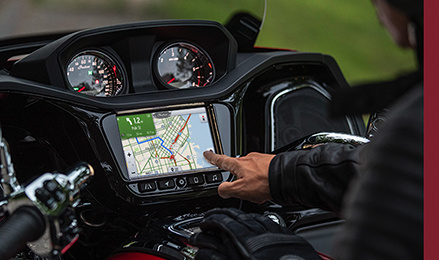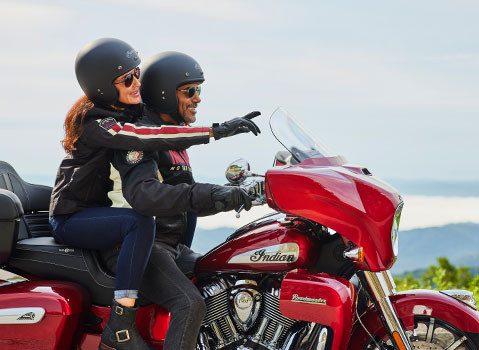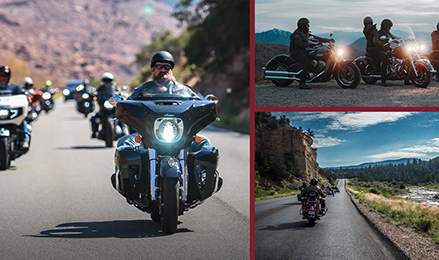
Guide to Motorcycle Group Riding
Tips for Taking Part in a Ride with Friends or an Organized Public Group
There’s more to a group motorcycle ride than just getting out on the open road with a crew of your close friends or a larger gathering of riding enthusiasts. You’ll want to prepare yourself and your bike before you roll, familiarize yourself with the etiquette of group riding and follow the safety measures specific to riding in numbers. You’ll also want to know as many ride details as you can before you head out so you can easily handle anything that comes up.
How to Prepare Yourself and Your Motorcycle for a Group Ride
Before you set out on a group ride there are a variety of things to consider that will make the entire experience safer and more enjoyable. Think about what clothing you’ll wear (and what clothing to pack), plus get a detailed understanding of the route you’ll ride. Then, make sure your bike is gassed up, has fresh oil, the tires are properly inflated and everything is running smoothly.
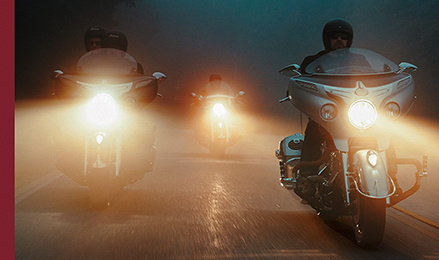
Expect the Sun, Prepare for Storms
When group riding, it’s important to keep an eye on weather forecasts for the day of the ride. Cut rides short or reschedule if storms are expected. Those pre-planned waypoints can also be great places to take cover if something unexpected pops up. Make sure the group knows the plan for bad weather so you don’t get separated.
What to Bring
The type of motorcycle you ride will affect what you can bring on your group adventure. A bagger is going to offer more room to stow a change of clothing if the sky opens up on you, or some rain gear if you plan to motor through a light drizzle. You can even plan multi-day group rides with a little larger bike under you, with extra racks and storage. A cell phone is also essential for each rider these days. Make sure everyone has each other’s number. And don’t forget to stow some water in a packable soft-sided cooler.
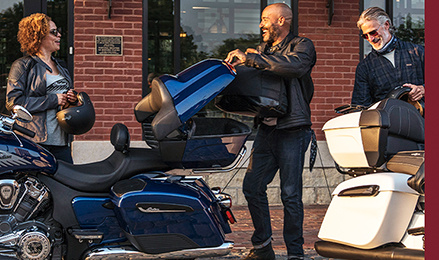
Make Sure Your Motorcycle Group Ride Follows Safety Protocols
With the pre-planning taken care of, it’s time to familiarize yourself with important safety tips for riding in groups. Understanding rider spacing, group etiquette and local laws can help you and everyone else ride safer. If your group goes over 8 riders, consider splitting into two or more smaller groups to keep everything manageable.

Meet with the Group Before the Ride
Whether you’re planning the ride or are along for the ride, it’s important for the group to meet up ahead of time to go over the plan. Everyone should know the route, what the planned stops are and what to do if a rider gets separated from the group. Everyone should also know who the leader is and who the sweep rider is.
Lead rider — sets the pace and knows the entire route—usually one of the most experienced riders in the group. The group leader is also responsible for keeping the pack from rubber banding, which happens when a lead rider increases speed too fast without notice and each successive trailing rider must go even faster to try to close the gap with the group.
Sweep rider — brings up the rear, watches out for riders in need of assistance and is responsible for protecting the group from behind. The last rider should also be one of the more seasoned riders in the group and may carry supplies for first aid or repairs in case of breakdowns.
Observe Local Laws
Each state is unique when it comes to motorcycle laws—from helmet use to lane splitting. You’re probably already aware of most of your own state’s requirements. But if your group ride rolls into another state, you’ll want to familiarize yourself with their local rules.

Know Your Hand Signals
Talking over the wind, road noise and roar of a handful of motorcycle engines is not realistic, so knowing and using the 16 different motorcycling hand signals is essential to creating a safe group riding environment.
Getting Passed or Passing Another Rider
Passing for a group of motorcycles requires an individual approach. On a two-lane highway, as each rider comes upon the vehicle the group is passing, each rider should evaluate the traffic from the opposite direction and pass only when safe. Do not blindly follow the rider ahead of you.
On a four-lane highway, once the lead rider starts to pass a vehicle the trailing sweep rider may move out into the passing lane if clear to provide cover for the other motorcycles in the group to enter the lane. Although each rider is still responsible for evaluating when it is safe to merge.
In either situation, once you have passed the vehicle, make sure you’ve left enough room behind you for the next motorcycle in your group to fall in.
If a vehicle passes your group and ends up trying to slip in between riders due to rubber banding, do not try to close them out. Give the vehicle enough space for everyone’s safety.

Group Riding Etiquette (Staggered or Single File)
Proper staggered formation, as shown in the diagram above, provides everyone with a clear space in front of them and to their side. With this approach, you have enough time to react to the rider directly ahead of you and enough space to the side if you must swerve around road debris or a large pothole, without affecting riders to your side.
When turning, riders may appear to take more of a single-file formation, with each rider taking their turn in order. Group riders may also adopt a single-file formation on roads with a lot of curves or switchbacks or during inclement weather.
Lost or Missing Rider
Your pre-ride meeting should establish what happens if someone goes missing or gets separated. Establish a communication plan for letting the group know a rider is no longer with the group. The missing rider should also know the communication plan if they get lost or drop off. The sweep rider is responsible for supporting any rider who drops from the pack.

Now Get Out There and Enjoy the Ride
A little preparation can go a long way toward making a group ride a memorable experience. Keep in mind, group rides are not for everyone. If you’re more of a solo rider who likes to set your own pace, then embrace it and be you. But if you’re looking for a little comradery among close friends, or a chance to meet new people who love to ride as much as you do, then you might want to give a group ride a try.



